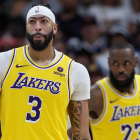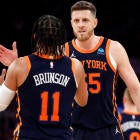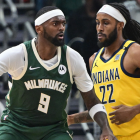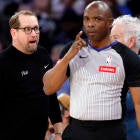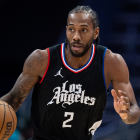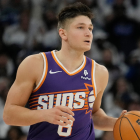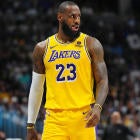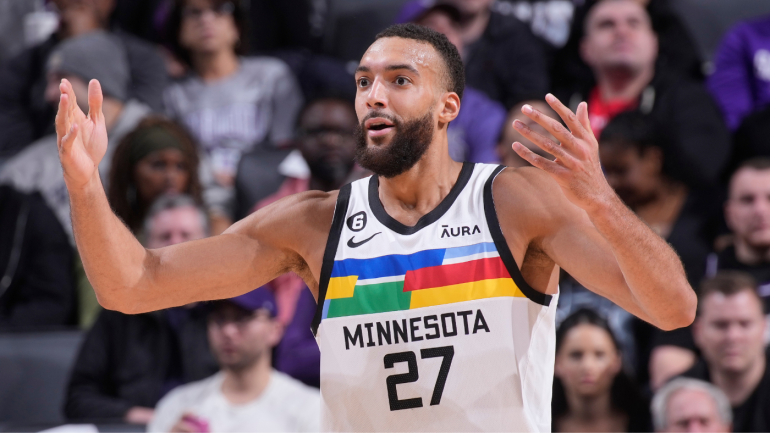
Remember what the Timberwolves did last July?
It was a lot and it wasn't yesterday, so we'll refresh your memory. Minnesota traded four first-round picks, one first-round swap, the draft rights to Rookie of the Year candidate Walker Kessler and veterans Malik Beasley, Patrick Beverley, Jarred Vanderbilt and Leandro Bolmaro to the Utah Jazz for three-time Defensive Player of the Year Rudy Gobert. It was the second-biggest package of assets ever traded for a single NBA player, trailing only the blockbuster deal the Los Angeles Clippers once made for Paul George. For such an investment, the Timberwolves likely expected an All-NBA performance and championship contention. Let's take a look at the season Gobert has had thus far in Minnesota.
- Went 13-13 in games in which he shared the court with Minnesota's other All-NBA big man, Karl-Anthony Towns, prior to Sunday.
- Was ejected from a game in December for intentionally tripping Oklahoma City Thunder forward Kenrich Williams.
- Was openly criticized in the locker room by former teammate D'Angelo Russell, who was traded for Gobert's former teammate, Mike Conley, at the deadline.
- Accused NBA officiating of being biased against the Timberwolves in favor of big-market teams.
- Punched teammate Kyle Anderson during a huddle in Sunday's regular-season finale against the New Orleans Pelicans.
The Timberwolves finished the regular season seeded eighth in the Western Conference. They needed a spirited double-digit comeback against the Pelicans Sunday just to stay out of ninth, and most of that comeback came after the team sent Gobert home for trying to sock Anderson. Key defender Jaden McDaniels broke his hand punching a wall in frustration, seemingly keeping him out of Minnesota's upcoming contests. Those are games the Wolves assumed they wouldn't need to play once they landed Gobert. To say that the Timberwolves have buyer's remorse right now would be an understatement. They made what will likely go down as one of the worst trades in NBA history. And it's only going to get worse.
This will likely be the first season since 2016 in which Gobert does not earn First-Team All-Defense honors. In fact, given the rise of players like Brook Lopez and Nic Claxton, Gobert probably won't even make the Second Team. His three-year All-Star streak was snapped this season as well. He'll turn 31 in the offseason, and his defensive value is predicated largely on his athletic gifts. Those are going to fade. He still has three years left on the supermax extension he signed in Utah. He will make $41 million next season, just under $44 million after that and roughly $47 million on his 2025-26 player-option. You could credibly argue that the player Minnesota traded five first-round picks for nine months ago is suddenly a negative-value asset.
That's what's so terrifying about all of this for the Timberwolves. There is no easy escape hatch here. If they want to even approach the asset value lost in the Gobert trade, they'd probably have to move the younger, more versatile Towns. There's an argument in favor of doing so. The Timberwolves finished 27-26 in the 53 games Towns missed, and Minnesota's post-deadline starting lineup of Conley, Gobert, McDaniels, Anderson and Anthony Edwards outscored opponents by 7.6 points per 100 possessions. It's a basic formula: surround a high-usage perimeter star and an elite rim-protector with shooting and defense and typically, good things happen. A Towns trade would allow Minnesota to double-down on that formula.
It would also mean sacrificing a homegrown 27-year-old with a more valuable skill set in service of the newcomer that just punched a teammate. That's a bitter pill to swallow. Keeping the two united doesn't feel sustainable either. Lineups featuring both of them just barely managed a positive net rating. Towns is at his best defensively in the aggressive scheme Minnesota ran last season. Asking him to play drop-coverage—the only viable system for a Gobert team—invites trouble defensively. His offensive gifts are squandered at power forward. His shooting breaks defenses when he's the biggest Timberwolf on the floor.
That leaves Minnesota in the rather unenviable position of at least trying to gauge Gobert's value on the trade market. The return, at best, would be pennies on the dollar.
Only four big men in the past five seasons have been traded for multiple first-round picks. Those big men were Gobert, Anthony Davis, Nikola Vucevic and Kristaps Porzingis. All four were reigning All-Stars in their 20s at the time of their trades. Gobert is neither. The three non-Gobert centers all averaged at least 23 points per game in the season prior to getting dealt (or, in Vucevic's case, the season in which he was at the deadline). Gobert is at a paltry 13.6 per game this season.
The logic of giving up as much for him as Minnesota did relied on him being a Defensive Player of the Year-caliber player. There's just not much evidence suggesting that he's still that dominant defensively. He averaged a career-low 2.1 blocks per 100 possessions this season. According to FiveThirtyEight's RAPTOR metric, he is having his worst defensive season since 2016, and opposing players are shooting 56.6% against Gobert within six feet of the basket. That is the worst figure of his career by far.
The downgrade from "best defensive center in the NBA" to "very good defensive center that rebounds, catches lobs and does little else" is enormous from a trade perspective. Such players have historically netted only a single first-round pick. In the past five seasons, that has been the price paid for Clint Capela, Jarrett Allen, Jakob Poeltl and Steven Adams as well as similarly skilled forwards like Larry Nance Jr. and Thaddeus Young. The market tends not to value these kinds of players much because they're relatively easy to find. You're not going to find a Gobert-level player for the mid-level exception, but you can usually get a reasonable, low-minutes facsimile for a fraction of the price.
That reality could scare plenty of suitors off. Teams have had to pay to dump contracts like Gobert's. In 2021, for instance, the Philadelphia 76ers spent a first-round pick to move Al Horford and the three remaining years on his near-max contract to the Oklahoma City Thunder. They got Danny Green in the process, but the deal gave Horford a negative valuation at the time. Horford was younger than Gobert is now, but he's always been a more versatile player, and neither are particularly effective scorers.
A player's trade price is ultimately determined by the market, though, and there are enough trade fits out there that he'd almost certainly garner some positive value in a deal. The Dallas Mavericks are an obvious fit here, for example. Their defense cratered after the Kyrie Irving trade and two of their top big men are about to become free agents. The quickest way to fix a leaky defense is to protect the basket. The Mavericks could match Gobert's salary with Tim Hardaway Jr. and Davis Bertans. They'll likely have a lottery pick this season to offer, and if they don't want to give that up, they could dangle a lightly protected pick in 2027, when Luka Doncic may be playing for another team.
The Clippers are a similarly logical fit. Ty Lue tends to prefer smaller lineups that emphasize offense, but the Clippers have slipped to 17th defensively this season. Kawhi Leonard, Paul George, Marcus Morris, Nicolas Batum and Marcus Morris are all in their mid-30's. If this postseason doesn't go as planned, it might be worthwhile for them to consider going a bit bigger and upgrading on Ivica Zubac. The Clippers have no shortage of mid-sized salaries to send Minnesota in this sort of deal, and as of this offseason, they'll have two tradable first-round picks.
These aren't exactly good options for Minnesota, of course, but good flew out the window with the five first-round picks Tim Connelly traded last July. The Timberwolves can either risk compounding one bad move with another or they can stand pat with a roster that just delivered arguably the most disappointing season in franchise history. All Minnesota can do from this point is hope to make the best of a bad situation.















